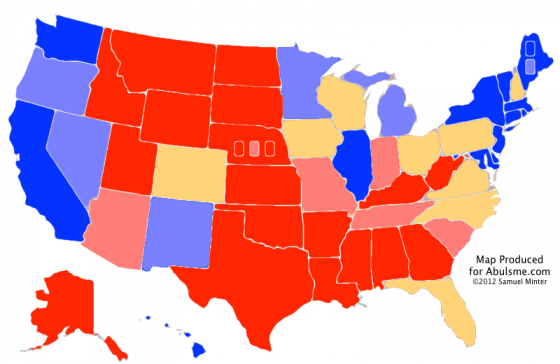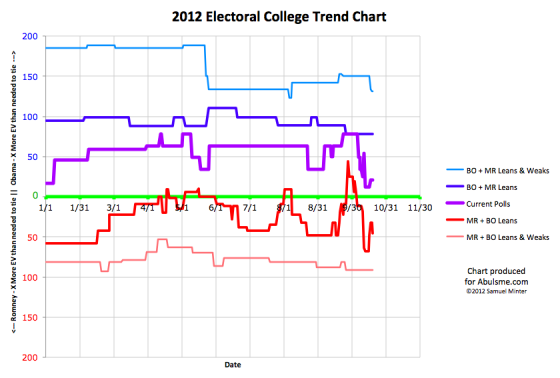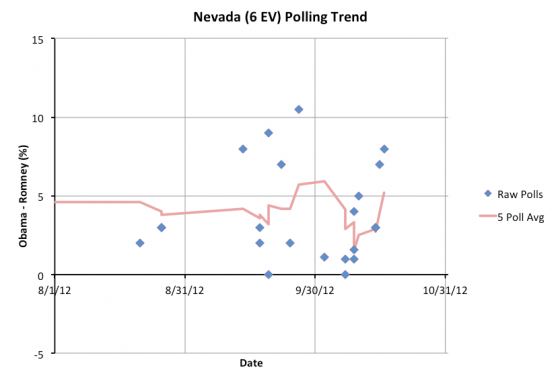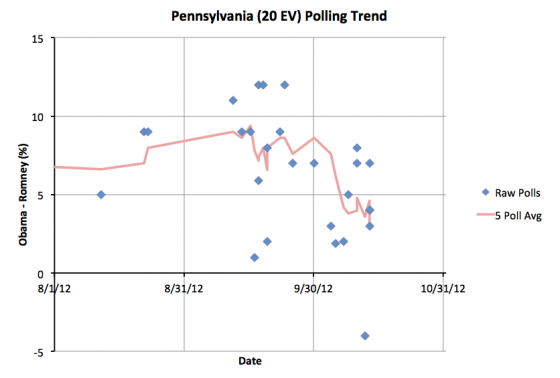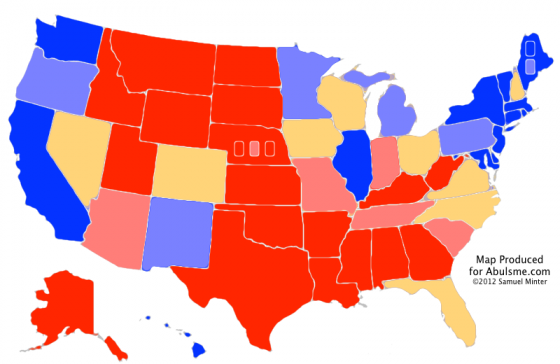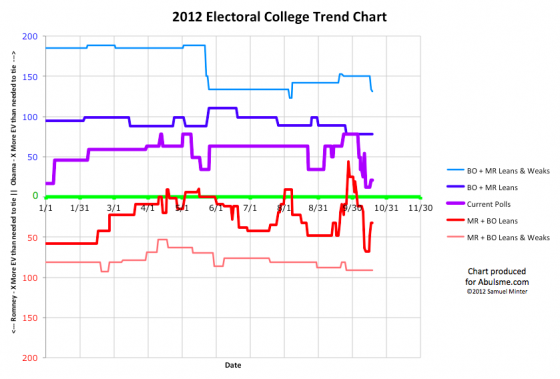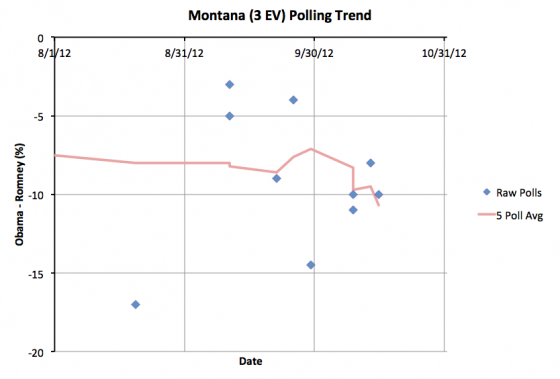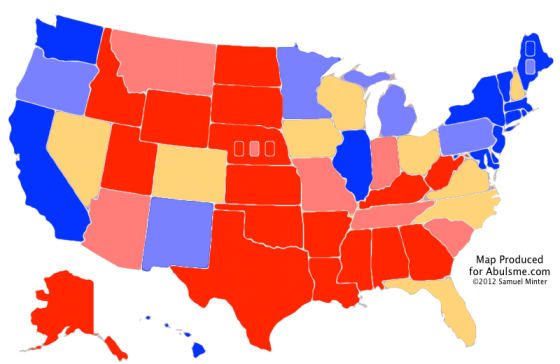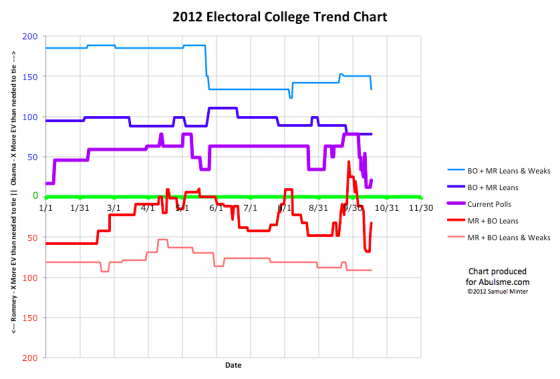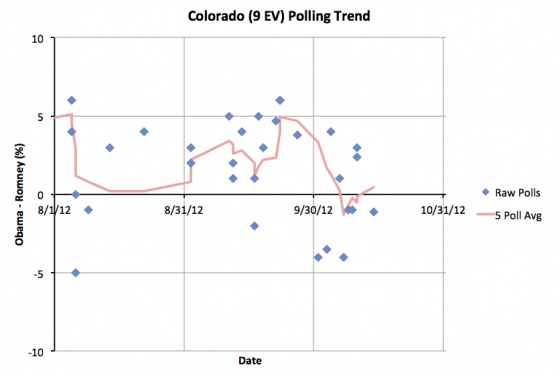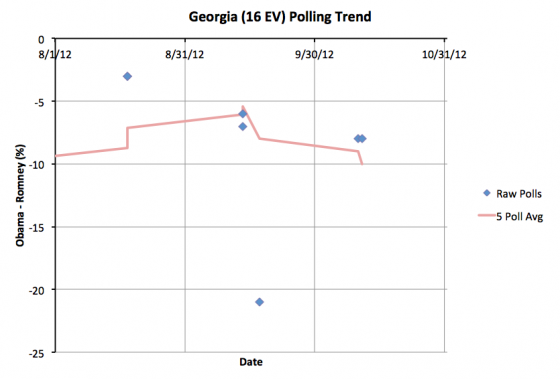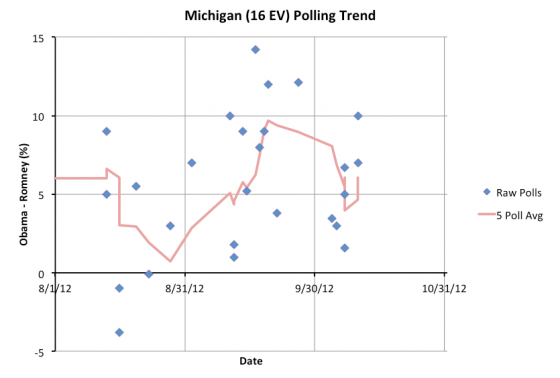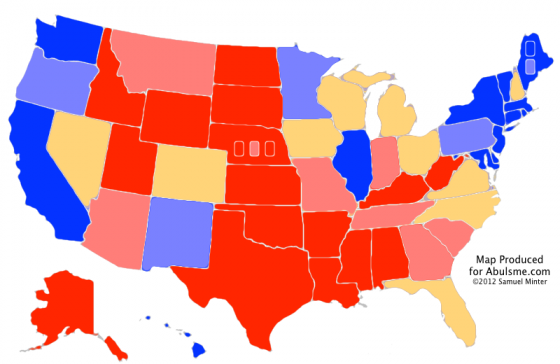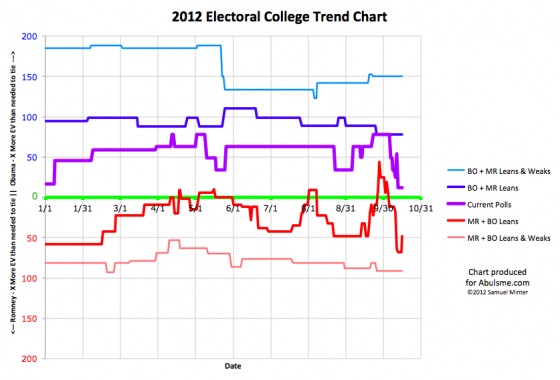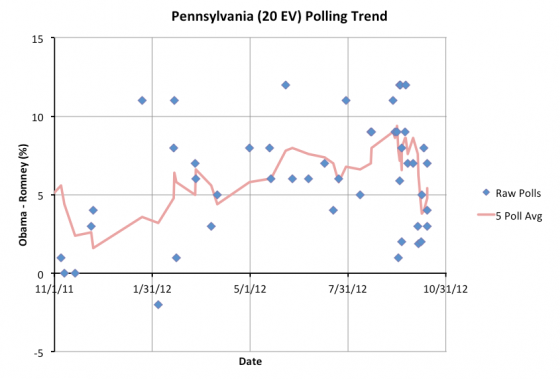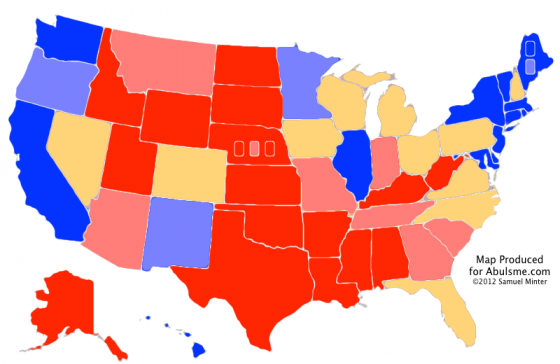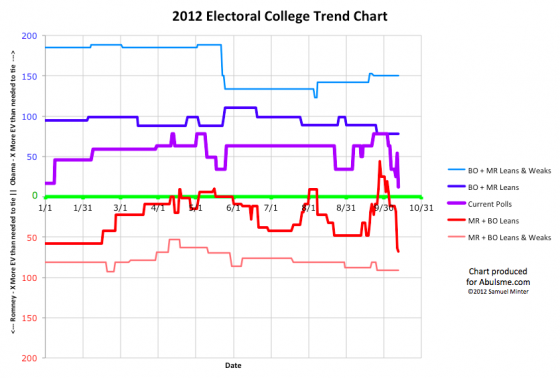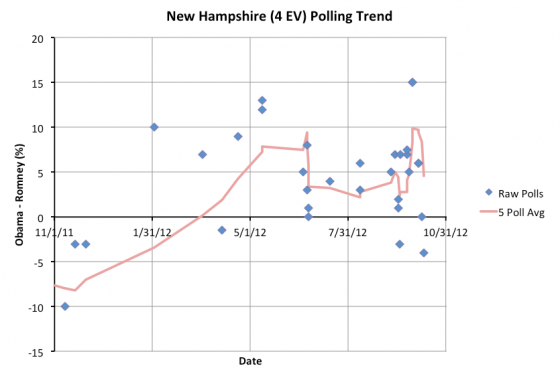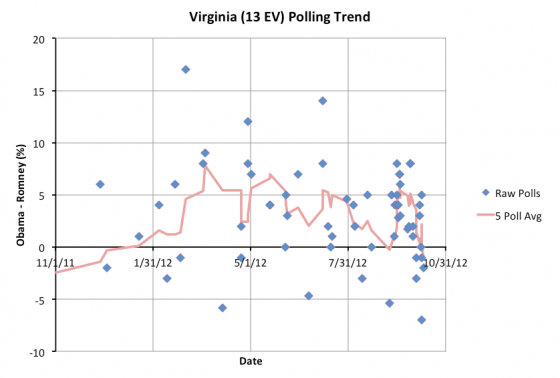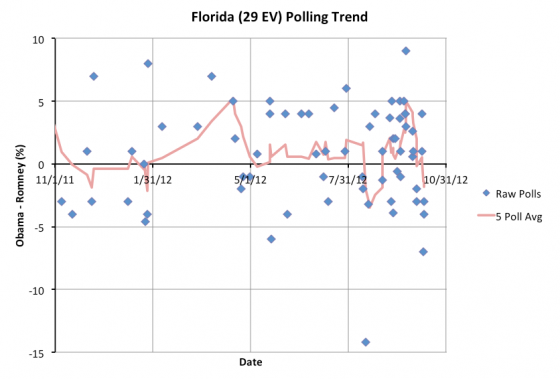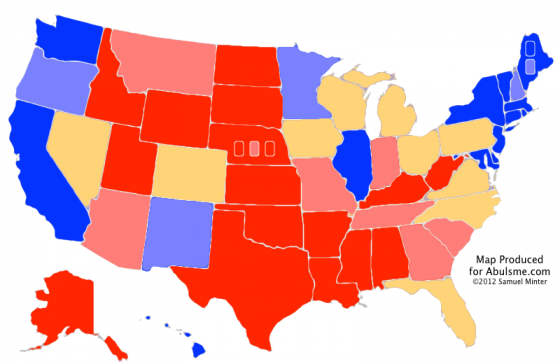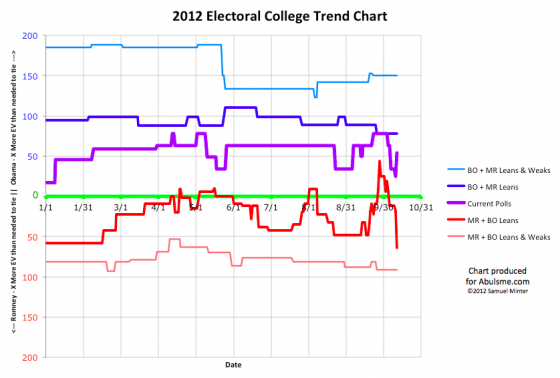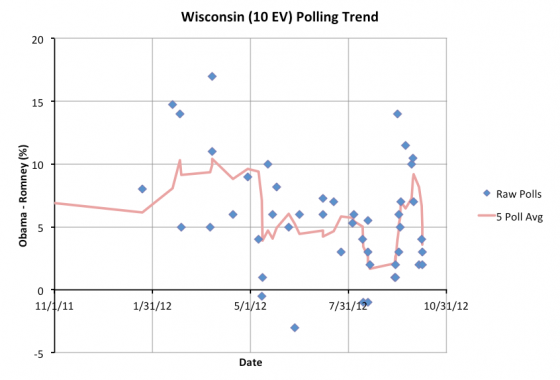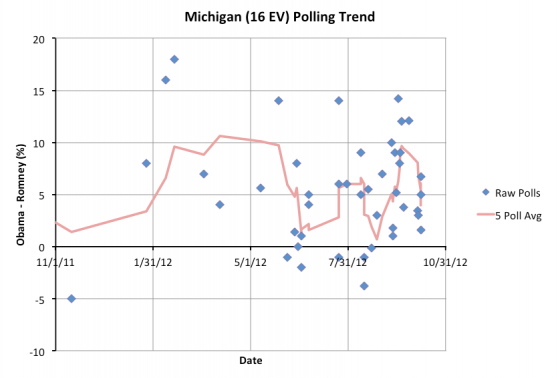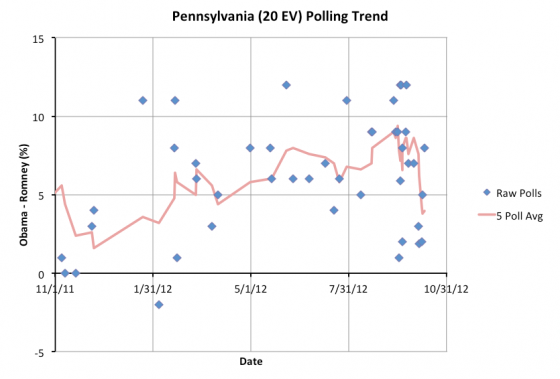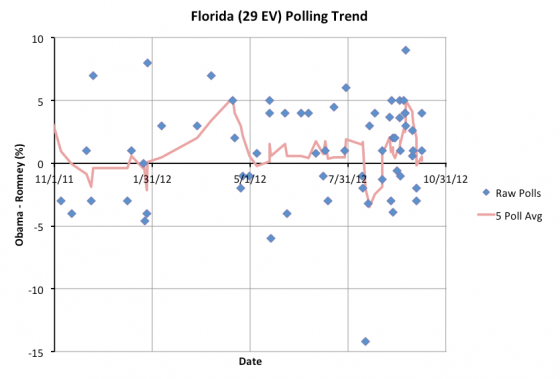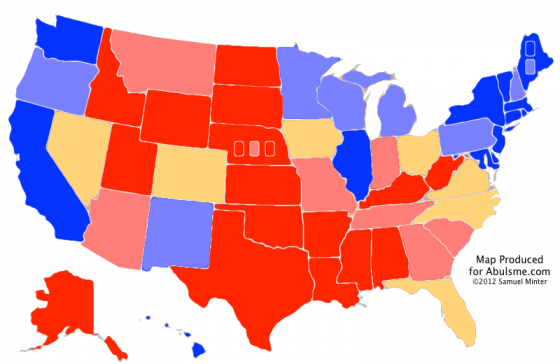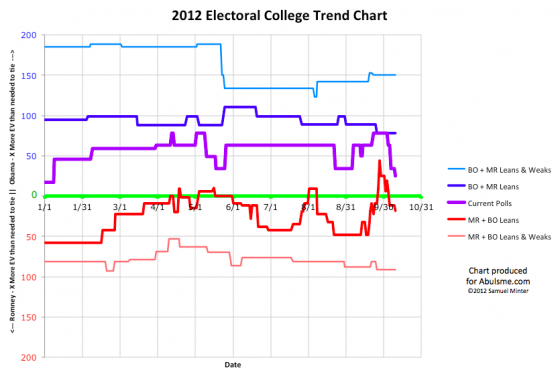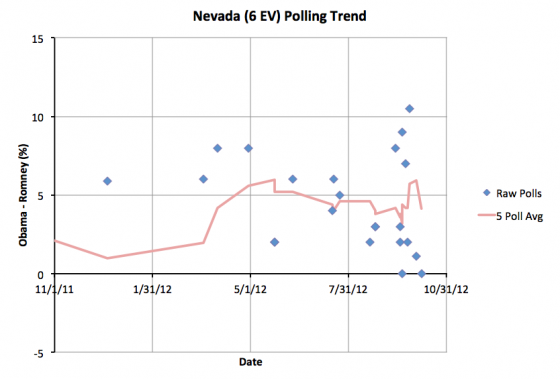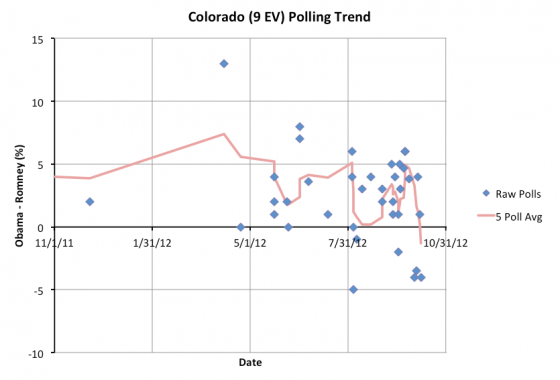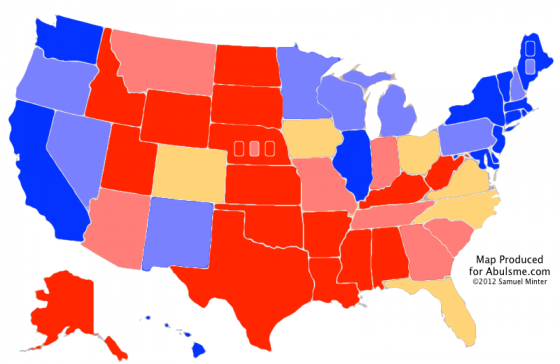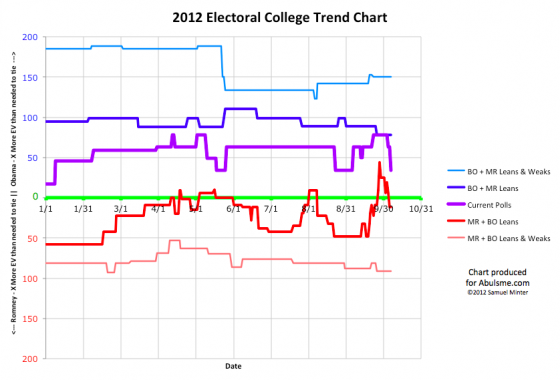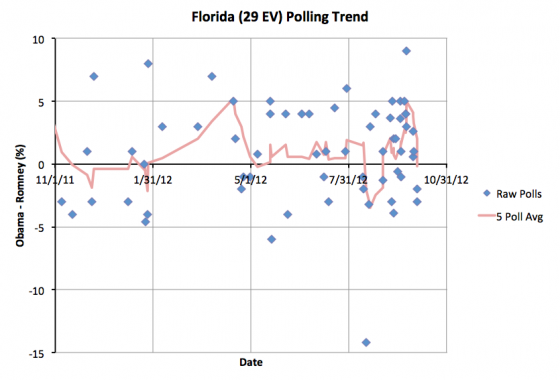|
Two states move today, one toward Obama, one toward Romney. As usual, in order of Electoral College strength: In the last three months Nevada has usually been “Leaning Obama”, meaning Obama has the advantage, but not by very much. In September Obama’s lead headed higher for a little bit, then dove again after the debates. Now it heads up again, with Obama’s lead in the five poll average now at 5.2%. Given this, Nevada now is classified as “Weak Obama” meaning it would take a pretty significant move for Romney to take the lead and win the state. So Nevada is no longer included in Romney’s “best case” scenario. Pennsylvania is a bit odd. Three days ago Obama’s lead topped 5% in the five poll average. But today we add a new poll that arrived out of order. It was still in the five most recent polls by the last day of polling, so it counted as a “recent poll” for us, but it was also the first poll since February showing Romney ahead in Pennsylvania, and showing him ahead by a relatively substantial 4% at that. This is way out of line with other recent polling in the state, so certainly LOOKS like an outlier. Especially since by the time it was released there were already polls taken after it that did not show that kind of movement. But I don’t do any outlier removal here. I just let the five poll average do what the five poll average does. For the moment, this means that Obama’s lead in Pennsylvania is now down 2.8%, with the peak above 5% erased. Because this was still a “current poll” I do not retroactively adjust the overall historical trend however. This potential outlier is now the 5th oldest poll I have in Pennsylvania, so it will age out with the very next Pennsylvania poll. Pennsylvania may or may not pop back to “Weak Obama” at that point depending on the results of that next poll. So this puts Pennsylvania back in play, with the possibility of Romney winning the state now back in his best case scenario. Which brings us to the updated summary:
We still have a close race. Obama is ahead, but Romney only needs to pull 21 more electoral votes over to his side to win. Right now the easiest way to get there is to hold North Carolina (15 ev, 3.8% Romney lead), Virginia (13 ev, 2.6% Romney lead), Florida (29 ev, 0.4% Romney lead) and then to pull ahead and take New Hampshire (4 ev, 0.5% Obama lead) and Ohio (18 ev, 2.8% Obama lead). There are many other combinations that will do it too. That just looks like the easiest to me at the moment. Note: Chart and map from the Abulsme.com 2012 Electoral College Prediction page. Both assume Obama vs Romney with no strong third party candidate and show polling as it currently exists. Things will change before election day. On the map red is Romney, blue is Obama, gold states are too close to call. Lines on the chart represent how many more electoral votes a candidate would have than is needed to tie under several different scenarios. Up is good for Obama, Down is good for Romney. Only one change today, Montana moving toward Romney: So, although there was some speculation about Obama contesting Montana in 2008… and he did end up making it close, losing the state by only 2.3%… this time around nobody has been talking about Obama trying to win Montana. Although there was one individual poll in April showing Obama only behind by 2%, the five poll average has never shown Obama closer than 6% behind Romney. For most of the year Montana has been in the “Weak Romney” category, meaning Romney is relatively safe, but if something major happened… perhaps a mirror image of the Obama decline after the first debate… then the state might become competitive. Instead, we see Romney’s lead on an increasing trend over the past few months, and with today’s update, Romney’s lead is now at 10.7% over Obama. So Montana moves to “Strong Romney”… essentially meaning that even if Romney completely implodes, he’d probably still win Montana. Since Montana isn’t even close to the competitive zone, this does not affect our models:
The race remains close. Obama is ahead. Obama has always been ahead. Romney still has NEVER taken the lead in my model. But if Romney wins all the states he is ahead in, he is only 21 electoral votes short of a 269-269 tie. He can get those 21 electoral votes in a variety of ways. Assuming Romney holds his current leads in Florida (29 ev, 0.4% lead), North Carolina (15 ev, 2.8% lead) and Virginia (13 ev, 4.0% lead), probably the easiest way to a victory right now is to win Ohio (18 ev) where he is only behind by 2.8% in the five poll average today, and then win any one of New Hamphire (4 ev, behind by 0.6%), Colorado (9 ev, behind by 1.3%) or Iowa (6 ev, behind by 2.5%). Of course, if he is winning Ohio, he will probably be close in Wisconsin (10 ev, 2.8% behind) and Nevada (6 ev, 3.9% behind) as well, and either of them would do the trick too. As of my sweep of polls a few hours ago, we only had TWO state level polls that finished after the second presidential debate. One in North Carolina and one in Ohio. The North Carolina one slightly improved Romney’s position but not enough to recategorize North Carolina, while the Ohio one had no affect on the five poll average at all, as it matched the margin of the poll it replaced in the average. Bottom line, no where near enough data to judge the effects of the second debate. Maybe in the next few days. Note: Chart and map from the Abulsme.com 2012 Electoral College Prediction page. Both assume Obama vs Romney with no strong third party candidate and show polling as it currently exists. Things will change before election day. On the map red is Romney, blue is Obama, gold states are too close to call. Lines on the chart represent how many more electoral votes a candidate would have than is needed to tie under several different scenarios. Up is good for Obama, Down is good for Romney. Three states move between my categories today. One moves toward Romney, two move toward Obama. That sounds like a mixed day, but on balance the benefit goes to Obama. As usual, lets look at the states in order by electoral college weight, but now I’ll zoom in to only show 3 months of polls rather than a year since we are getting close to the end (under three weeks!) and polls are coming in so quickly… First up, Colorado. According to the five poll average, the state went from an Obama lead of 4.9% on September 23rd, down to a Romney lead of 1.3% on October 8th. With today’s update, Obama takes a very slim 0.5% lead again. This is essentially a tie, but with this the state tips ever so slightly back onto the Obama side of the ledger. Georgia is Romney’s one piece of good news for the day, but there are a bunch of caveats. Romney’s lead in Georgia hits 10%, so we move it to the “Strong Romney” category. But this is largely due to one poll from September that looks like an outlier, so absent other movement backing up that poll, Georgia is likely to revert back to “Weak Romney” once that poll ages off. If we even have enough more polls in Georgia before the election to do that. It has been pretty sparsely polled. More to the point though, it doesn’t really matter if Romney’s lead in Georgia is just under 10% or just over 10%. Either way, Georgia is a Romney state, and there is no realistic scenario where Obama wins Georgia. Georgia is safe for Romney. So while winning by a bit larger margin may be “nice” for Romney, it doesn’t actually help him at all in the contest with Obama. Obama’s lead in Michigan topped out at 9.7% on September 20th. It declined to a 4.0% lead on October 8th. It has now popped back up to 6.1%. It seems that the post-debate movement toward Romney was relatively short lived. In the last three months the degree of Obama’s lead in Michigan has bounced around quite a bit. It has however always been a lead. A few isolated polls aside, Romney has never held the lead in the five poll average in Michigan. For awhile there it looked like Michigan was close. Not so much any more. All of this leads us to the new summary:
Since Georgia doesn’t affect any of these three situations, what we see here is basically just Obama strengthening again. Some of the gains Romney had made in the last couple of weeks are just slipping back away from him. Yesterday Obama’s lead in Pennsylvania once again became substantial enough to not call it a close state. Today the same happens to Michigan. And Obama retakes the lead in Colorado. It certainly looks like Romney peaked between August 12th and August 15th and things are now heading back in Obama’s direction, without Romney ever actually taking the lead in the electoral college model. If initial reactions to the second debate are any indication, at the very least we should expect no further downward plummeting by Obama, and perhaps even more additional upside for Obama beyond that. Caution needs to be urged in interpreting this though. Only a small number of states have moved so far, and just barely over the respective category lines. More polls could easily reverse the recent changes. If these initial trends continue over the next few days though, we’ll get a very solid picture. None of the polls included so far include the time period after the second debate. That will of course be the next thing to watch for. Will there be big noticeable effects from the second debate as there were after the first one? Of course to win, Romney needs to do more than just hold on to his previous gains. He actually needs to bring even more states over to his side in order to win. If he couldnt’ do it last week, then what exactly can he do now to make it happen? At the moment Obama’s lead is still very narrow. Romney has many potential ways to win. It is still a close race. But the movement seems to be shifting toward Obama again. Note: Chart and map from the Abulsme.com 2012 Electoral College Prediction page. Both assume Obama vs Romney with no strong third party candidate and show polling as it currently exists. Things will change before election day. On the map red is Romney, blue is Obama, gold states are too close to call. Lines on the chart represent how many more electoral votes a candidate would have than is needed to tie under several different scenarios. Up is good for Obama, Down is good for Romney.
After a few days with no changes, one state changes categories today and hey, for the first time in awhile, the movement is toward Obama: Obama’s lead in Pennsylvania in my five poll average peaked at 9.4% back in mid-September. On the eve of the first debate, this was down to 8.6%. By October 11th, that lead had dropped to 3.8%. Romney actually made Pennsylvania close… but since then the polls have started looking better for Obama again, and the five poll average rises back up to a 5.4% Obama lead. This pulls the state back out of my swing state category and into the “Weak Obama” category, but just barely. Note that even in the dip, not a single poll showed Romney ahead in Pennsylvania. The last time any poll showed Romney ahead in Pennsylvania was way back in February. Although Obama’s lead dipped in Pennsylvania in the post-debate period, a Romney win here seems pretty unlikely if this is indeed the end of the downward post-debate trend. There are too few polls as of yet to know if this is an actual reversal of the recent trend, or if it is just the polls being jittery. For the moment though, the five poll average pulls the state out of Romney’s best case:
Romney’s best case is 20 electoral points weaker, but his overall position is still way better than it has been for most of the year. Obama is still ahead. Romney has still never actually pulled ahead in the electoral college analysis. But it is close. It is still very close. The question remains what it has been for at least the last few days… Has Romney peaked? Or can he pull a little more support in his direction? Right now Romney is behind, but barely. Just a LITTLE more movement in his direction would have him in the lead. But the first debate had already caused a very large movement compared to where the race stood for most of the year. Is there really room for more movement? Or has Romney hit a ceiling? The move toward Obama in Pennsylvania may well be the start of a more general reversion in the polls to something more like the Obama leads we’ve seen most of the year. Or it might not. Too soon to tell. But with the second presidential debate in less than 16 hours, whatever trends may have been underway up through today will get replaced by reactions to the new news cycle. If Obama puts in another sub-par performance, maybe he drops further and Romney takes the lead. If so, Obama is in real trouble. Otherwise, with an “OK”, “Good” or “Great” performance from Obama, we’ll probably start to see some more Obama gains in the polls as those who moved away from him in the last two weeks think to themselves “OK, maybe he’s not that bad after all.” In that case, Obama retains his position as favorite, and maybe even starts making it look inevitable again if he does really well. So… debates almost never make a difference, except when they do… and this next debate is another critical one. So we’ll see what happens… Note: A poll added today in North Carolina that were older than the “last five” changed the date North Carolina last moved from Lean Obama to Lean Romney from October 4th to October 8th. The historical trend chart has been adjusted starting with today’s update. Note: Chart and map from the Abulsme.com 2012 Electoral College Prediction page. Both assume Obama vs Romney with no strong third party candidate and show polling as it currently exists. Things will change before election day. On the map red is Romney, blue is Obama, gold states are too close to call. Lines on the chart represent how many more electoral votes a candidate would have than is needed to tie under several different scenarios. Up is good for Obama, Down is good for Romney. Three states changing categories today. All three moving toward Romney. As usual, lets look at them from smallest to largest in electoral college strength: First up, New Hampshire. Before the first debate Obama was up to a 9.9% lead here. Now with 4/5 polls after the debate, that lead slips to 4.6%. This is in line with the drops we’ve seen in a bunch of other states. Obama still has a lead here, but it is now small enough that it could easily slip away. New Hampshire has been here before. It had only spiked to a big Obama lead a few weeks ago, when Romney was at his nadir. So this is perhaps New Hampshire just returning to form as a close state leaning slightly toward Obama. Last time Virginia changed status, I noted that it had been bouncing between Lean Obama and Weak Obama, but perhaps it was ready to break out of that pattern. Indeed it has. This time Obama’s lead continued to drop. After peaking at 5.1% a few days before the debate, Obama’s lead slowly disappeared, and with today’s addition, the five poll average now stands at a 1.0% Romney lead. Romney has been ahead before in Virginia, but it was very short lived. The question of course is if this time he can hold the lead or if Virginia will revert to “normal” which is a narrow Obama lead. Just yesterday Obama had retaken a very slight lead in the Florida five poll average. Today that slips away, and with some relatively strong polls, Romney ends up with a 1.8% lead at the moment. Florida is still very close. All the states we have talked about today are very close. But the momentum here, as in most other states in the last week and a half, has been toward Romney. So, the revised summary:
We are still seeing what is fairly obviously fallout from the first debate. It has just taken different amounts of time for there to be enough polling in different states to show it. All considered, it looks like we have seen one of the biggest debate effects ever in a presidential election. The level of self-inflicted damage by Obama is amazing. Of course, when this started, Obama had a substantial lead. So even after all of this, Obama is still ahead and is still the favorite. Surely we must NOW be close to a ceiling for Romney, right? Well, maybe not if Obama doesn’t redeem himself in the next debate. But assuming the absence of another catastrophic fail, it seems like sometime soon we’ll need to start seeing some reversion to the mean, which in this case would mean a bit of strengthening for Obama. I don’t have the time today to again do a rundown of the current margins in all the swing states, but suffice it to say that if Romney holds on to all of the states he is currently ahead in, Romney only needs 13 more electoral votes to win. He can get that in a number of ways at this point. The easiest way is still to win Ohio (18 ev). Romney is currently behind in Ohio by only 2.2%. Ohio is within reach. Romney just needs to convince a few more people, or energize greater turnout. Alternately, and a lot more fun, Romney could win Iowa (6 ev) where he is currently behind by 3.2% and Nevada (6 ev) where he is currently behind by 1.6%. That would result in a 269 to 269 electoral vote tie. Assuming no faithless electors, that would throw the election into the House of Representatives, where Romney would almost certainly win. The last time a Presidential election was thrown to the house was 1824. That would be so much fun to watch happen! It is still unlikely though. But a guy can hope! Bottom line though, right now Obama is ahead, but only by the very slimmest of margins. If Romney can hold on to his gains from the last couple of weeks (Obama actually peaked a little before the first debate) and move things just a LITTLE more, then he can win this. I am quite sure Obama would like the Romney “debate bounce” to be over now. We’ll start seeing polls that factor in the VP debate any time now. It is unlikely to have as profound an effect as the first debate and therefore I don’t anticipate Obama erasing Romney’s recent gains. But perhaps the bleeding will finally stop. Note: Chart and map from the Abulsme.com 2012 Electoral College Prediction page. Both assume Obama vs Romney with no strong third party candidate and show polling as it currently exists. Things will change before election day. On the map red is Romney, blue is Obama, gold states are too close to call. Lines on the chart represent how many more electoral votes a candidate would have than is needed to tie under several different scenarios. Up is good for Obama, Down is good for Romney. In terms of the categories I use to classify states based on the average of the last five polls, today was another brutal day for Obama. It just keeps getting worse. There had been some talk about the “bump” from the debate having bottomed. I’m just not quite seeing it yet. One state does move in Obama’s direction today, and I’ll get to that, but for the most part the theme today is states that had once looked pretty safe for Obama now once again looking competitive. So lets look at the states, from smallest to largest in the electoral college: Immediately before the debate, Obama’s lead in Wisconsin stood at 9.2%. As of today’s update, it has dropped to a 3.6% lead with 4/5 polls now from after the debate. Huge drop. This of course puts Wisconsin back in “Lean Obama” territory, meaning Obama is ahead, but by a small enough margin it is easy to imagine Romney taking the state. Wisconsin has been in this category before of course. But it is a big change from the time period right before the debate. Michigan looks pretty similar to Wisconsin. Right before the debate Obama had a 9.0% lead. Now he has a 4.0% lead with all five polls in the average after the debate. So Michigan also returns to “Lean Obama” and I include a win here in Romney’s best case. Does the pattern look familiar? Before the debates, Obama had a 8.6% lead in Pennsylvania. Now with all five polls in the average after the debate, Obama’s lead is down to 4.0%. So Pennsylvania also comes within reach for Romney. Yes, he is still behind. In all three of these states. But they are all close. Another bad new cycle for Obama, and seeing these states move over to Romney does not seem impossible. The one move toward Obama today is the biggest state moving today, but Obama folks should not get too excited. The five poll average for Florida moves from a 0.2% Romney lead yesterday to a 0.2% Obama lead today. Those margins are negligible. Either way, Florida is incredibly close and could very easily go either way. Before the debates Obama had a 3.2% lead in Florida, so his drop has not been as large here as elsewhere. But in a state this big and this close, every little bit counts. Florida is hyper close, but I have to classify it somewhere, and for the moment, for today, it goes back into the Obama column, where it has been most of the year. Just barely. Which brings us to the new summary of the race:
Romney’s best case is better than it has been all year. He beats his post-primary peak from the beginning of September, and he even passes all time peak from January. Obama’s lead in state after state has just been washed away in the aftermath of the first debate. Obama is still ahead in these states for the most part… but what once had been substantial leads are now very narrow. This is clearly not where Obama wanted to be right now. Now, the current status does improve for Obama compared to yesterday because of Florida flipping categories, but as I mentioned above, the margin in Florida is essentially zero. So the difference between today and yesterday isn’t really substantive on that front. Either way, Florida is a toss up at the moment. So to try to get a little more insight, although I won’t do this every time, lets once again look at the actual current margins in all of the close states to see how they rank. With just the states he is ahead in by more than 5%, Romney starts out with 191 electoral votes. From there Romney needs 78 more electoral votes to tie, 79 to win. Ranked in order of current polling, these are the current “close” states:
That is a lot of “close” states. Before the debate, we were down to just a handful of close states. No more. Anyway, if Romney pulls those states toward him “evenly” then a move of just over 2.2% more in his direction would get him all the states through Virginia on the list above, which would give him an over all win. Obama is still ahead. It is worth repeating that. But this race is so much closer than it was before the first debate. And Romney has so many more “paths to victory”. The easiest route is though Florida, Ohio and Virginia. But there are now many more options available as well. Are we now at a ceiling for Romney though? Has he picked up about all of the “persuadable” votes that he can? Is there really headroom to move higher? If not, then it still isn’t enough. Obama will win. If the Obama folks screw up more, and the Romney folks effectively capitalize on it though… then maybe Romney ends up with more room to go up further. The next event expected to have the potential to move numbers is of course the Vice Presidential debate… a few hours from the time I am posting this update. We probably won’t really start seeing any move from that debate in the state polls for a few days, but this is probably one of the last moments we’ll really be able to look at the poll numbers and attribute the motion directly to the first debate. Starting with the VP debate, things get more muddled again, and more factors are at play. But looking at things right now, it is clear that the debate had a devastating short term effect. It was NOT enough to put Romney in the lead when you look at the electoral college. But it was enough to take what looked like an insurmountable lead for Obama and turn it into a tight race. The big question now is does it stay a close race, or does Obama start to claw back his previous lead. Or… of course the third option… does Romney/Ryan score some more big blows and actually start taking the lead in this race. Note: Chart and map from the Abulsme.com 2012 Electoral College Prediction page. Both assume Obama vs Romney with no strong third party candidate and show polling as it currently exists. Things will change before election day. On the map red is Romney, blue is Obama, gold states are too close to call. Lines on the chart represent how many more electoral votes a candidate would have than is needed to tie under several different scenarios. Up is good for Obama, Down is good for Romney.
Two states changing status today, and both are bad news for Obama. Lets get right to it: Prior to the debate last week, Obama’s lead in the five poll average in Nevada was 5.9%, which was a substantial enough lead for Obama that Nevada was not in the list of states that were within reach for Romney. We now have the first post-debate poll, and it shows a tied race in the state. This is just one poll out of five, but it causes the five poll average to drop to a 4.1% Obama lead. So once again I list Nevada as just “Lean Obama” and it contributes to Romney’s best case. Although it is a drop from where the state was before the debate, “Lean Obama” is actually where Nevada has been most of the last year, so to some degree this is reversion to the mean. Obama had a bunch of strong polls in September, but those are now in the rear view mirror, replaced by the worst numbers he has had in the state all year. (It is important to point out that some of these bad numbers were from polls taken BEFORE the debate.) The five poll average is still buoyed by some strong late September polls. Unless Obama gets a quick bounce back in the next few polls, I expect Obama’s lead in Colorado will diminish further as those polls age off. In Colorado before the debate Obama was 3.3% ahead in the five poll average. There have now been four polls that ended after the debate and the state flips to a 1.3% Romney lead. This is the first time in the last year that Romney has been in the lead in Colorado according to the five poll average. Unlike Nevada, where the state was down from a spike toward Obama, but had so far only returned to well traveled territory, in this case Romney is breaking new ground. Romney adds what had been a narrow but consistent Obama state to his column. So, the new summary:
Before any discussion, time to eat some crow. On September 6th I said:
So what is the comparison between now and the beginning of September?
Well, OK. I never specified how exactly to judge this, but two out of three of the lines being better than they were seems like it should qualify, especially since one of them is the “current” line. By that mark, Romney is now at the best point he has been since the very beginning of January. To be fair to myself, from that moment onward, in almost every update, I did mention that there was one way for Romney to come back again, and that was for Obama to majorly screw up. I perhaps stated this most clearly in my update from September 27th, which turned out to be Obama’s peak:
If you believe the most hyperventilating reports out there, a catastrophic Obama implosion is indeed what seems to have happened at the first debate. It seems it was not as unlikely as I expected. I presumed both Obama and Romney would put in not great but competent debate performances and the net effect would be essentially zero. Instead we saw a brand new Romney, hitting his stride in a way he never had in the previous year, and an Obama who looked like he didn’t want to be there and was phoning it in at best. Although Obama peaked before the debate, as each post-debate poll comes in, what a couple of weeks ago seemed like an insurmountable lead for Obama is getting transformed into a genuinely close race. A number of people doing detailed analyses of the polls have pointed out that if you look carefully at the dates on both state and national polls, there is tentative evidence that Romney’s debate bounce may have already peaked and is now starting to recede. So this may be a good time to do another detailed look at where the swing states stand, and what it would take for Romney to win. First thing to point out… despite the fairly significant drop Obama has seen since his peak… he is still ahead! (For the moment anyway.) Some national polling averages now show Romney ahead in the popular vote, but remember we do not have a national election, we have 51 smaller elections. Looking at the states using my five poll average, here is where we now stand, looking not just at my categories, but also specifically at the magnitude of the candidate leads in the close states. With only the states where Romney is ahead by more than 5%, Romney gets to 191 electoral votes. Then we add in the close states where he is ahead:
That gets Romney to 244 electoral votes if he can hold his lead in those three states. You need 269 electoral votes to tie (a situation Romney would probably win in the house) or 270 electoral votes to win outright. So Romney needs 25 more electoral votes to tie, 26 to win. To get there he needs to start pulling ahead in states where Obama is currently ahead.
There are a number of combinations that will get Romney to 270, and any of those four close states could easily flip. They are all close enough that the lead can disappear overnight. With the current state of the polls though, the easiest way for Romney to win seems to be to flip Ohio and Virginia, both of which are now looking exceptionally close. Prior to the debate, Obama had a 7.8% lead in Ohio… now down to 0.4%. That is a massive move in such a short time. Prior to the debate, Obama had a 4.3% lead in Virginia, now down to 1.0%. That’s a smaller move, but not insubstantial. If Romney can move each of those just a LITTLE bit further, then it would put him ahead in my “current” electoral college model for the first time ever. For almost all of the last year, while Romney’s best case was to win, I’ve been able to repeatedly say that hitting the best case was difficult. Romney would have to almost sweep the close states, and during most of that time, Romney was behind in most of those close states. It was a tall order. Not so much any more. Romney is still behind. But both Ohio and Virginia are in easy spitting distance. A very slight move in those states, and he pulls ahead. Then if he manages to stay ahead, perhaps even consolidating those leads, then he wins on election day. For the first time since January, this looks like a close race. The question of course is how long lasting this “debate bounce” is. Can Romney hold onto his gains… and extend them a little further to eke out a narrow win? Or do we start reverting back to where the race has been most of the year? Do we end up back at the “everybody wins the states they are ahead in” line being at Obama 332 to Romney 206 where it has been more often than anywhere else? The “feel” of the race has certainly changed. Obama was knocked on his heels and is now on defense. At long last, Romney has repositioned himself toward the center, making a play for the voters he needs to win over to win. To win though, he needs to not just hold his gains so far, but pull things a bit further toward him. If Obama on the other hand can just hold on and prevent any further losses, he wins. If Romney’s bounce recedes (as some say is already happening) then once again Obama wins. It seems likely that we will indeed see some reversion to the mean, which would favor Obama. But if Obama has another bad debate, or in general if he can’t shift the narrative back in his favor in the next few weeks, he is in big trouble. Romney isn’t in the lead yet according to my classifications… but a few more good polls and he is there. He is close. Really close. Note: Chart and map from the Abulsme.com 2012 Electoral College Prediction page. Both assume Obama vs Romney with no strong third party candidate and show polling as it currently exists. Things will change before election day. On the map red is Romney, blue is Obama, gold states are too close to call. Lines on the chart represent how many more electoral votes a candidate would have than is needed to tie under several different scenarios. Up is good for Obama, Down is good for Romney. Another state moving dramatically toward Romney based on post-debate polls. This time it is Florida: Prior to the debate the five poll average in Florida was a 3.2% lead for Obama. Florida had favored Obama in the average since September 6th and had even hit a 5% Obama lead for a few days. Both polls taken since the debate show Romney ahead however, and now the average flips back toward Romney. With 2 polls after the debate and 3 from before the debate, I now have Florida with a 0.2% advantage for Romney. 0.2% is of course so close to zero that the only way to really interpret this is as a tie. Florida could go either way. Florida is now even closer than North Carolina, where Romney has an 0.8% lead. And THAT was really close. All of the “close states” could easily be seen going either way when votes are actually cast, but at the moment Florida and North Carolina are the closest of the close. This makes the new summary as follows:
The “Current Status” now matches the best Romney has done since the primary season ended. (He was actually even slightly better than this at the very start of the year in January.) His “best case” hasn’t caught up to his September peak yet, but if he won every state he is ahead in at the moment, he puts in a better performance than he has since early September. That scenario still has Romney losing of course, just by less than before. To actually win, he needs to pull more than 34 additional electoral votes over to his side. We now have six “close” states. Here are the current margins in those states based on my five poll average:
Romney’s path here… first consolidate North Carolina and Florida. Then he NEEDS to flip Ohio. Colorado, Virginia and Iowa wouldn’t be enough without Ohio. If he has managed to flip Ohio, he has probably already managed to flip the others. If he does, then he wins. There are not yet any polls in Iowa from after the debate, but if we look only at post-debate polls, Romney is already ahead in Colorado and Virginia, and is tied in Ohio. Two polls, the most we have post-debate in any state, is still not very much. It will be good to get a few more polls to confirm these moves. If the moves are substantiated by more polls, it will have been a pretty big move toward Romney based on a debate. The Obama campaign is trying to pivot hard to being more aggressive, and to calling Romney out on flip flopping and misrepresenting his own positions, and perhaps a bit on picking on Big Bird… we’ll see if it works. I suspect however that Obama’s performance at the next debate will be more critical. To move things back in his direction again he needs to basically show the performance at the first debate was an aberration. Now, to win Obama doesn’t NEED to start moving things back in his direction… he just needs to stop further movement toward Romney. Obama is still ahead. By a not insubstantial margin. When discussing a similar status in the models a few weeks ago, I talked about how good the position was for Obama. In a static picture, this is still a pretty good map for Obama. It takes a bit of a stretch to get to Romney winning. Possible, but a stretch. The difference is the recent movement. In September, every new poll was showing things looking even better for Obama. Now almost every new poll seems to be showing things better for Romney. Romney isn’t winning, but the motion is in his direction. Obama may still be ahead, but to start feeling comfortable again, he needs to stop bleeding support in the key states. Note: Chart and map from the Abulsme.com 2012 Electoral College Prediction page. Both assume Obama vs Romney with no strong third party candidate and show polling as it currently exists. Things will change before election day. On the map red is Romney, blue is Obama, gold states are too close to call. Lines on the chart represent how many more electoral votes a candidate would have than is needed to tie under several different scenarios. Up is good for Obama, Down is good for Romney. |
||||||||||||||||||||||||||||||||||||||||||||||||||||||||||||||||||||||||||||||||||||||||||||||||||

